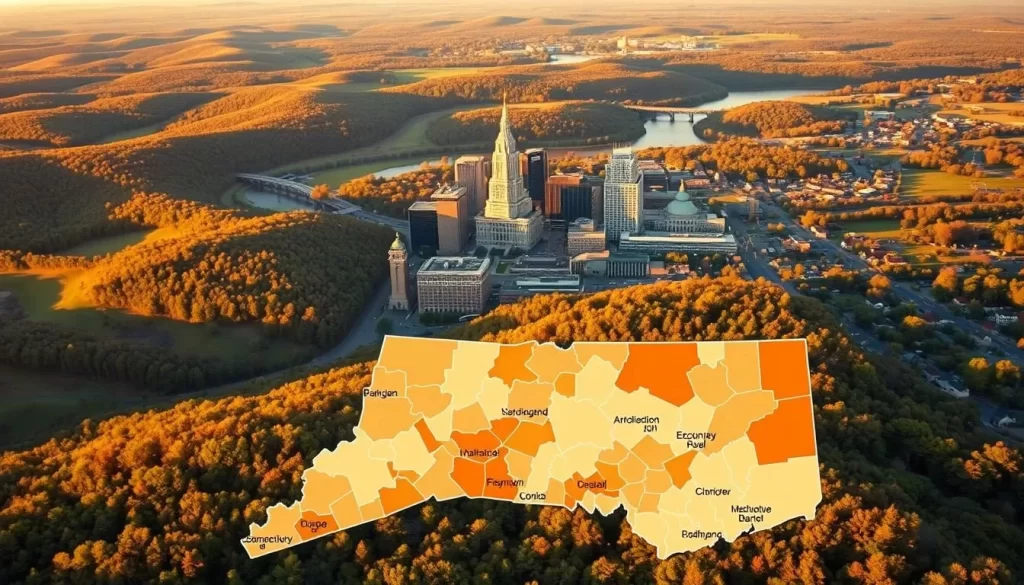✓ Accommodations✓ Flights✓ Rental Cars
You’re about to explore the fascinating linguistic landscape of Connecticut, a state with a population of approximately 1.39 million households. Despite its relatively small size compared to other states in the United States, Connecticut presents a diverse tapestry of languages.
You’ll discover that while English is the predominant language spoken throughout the state, Connecticut surprisingly has no officially designated language. This is despite multiple legislative attempts to establish English as the official language. Moreover, around 22.1% of households, which translates to about 307,190 households, regularly communicate in languages other than English at home.
This linguistic diversity is a reflection of the state’s rich cultural heritage, shaped by centuries of immigration patterns. As you delve deeper into this article, you’ll gain insights into the most widely spoken languages in Connecticut and how the state’s language services cater to its multilingual population.
The Linguistic Landscape of Connecticut
As you explore Connecticut, you’ll discover a rich tapestry of languages that have evolved over time. Originally, the population was primarily Algonquian-speaking Native Americans, with 16 unique tribes and approximately 5,000 to 7,000 members.
By 1790, the state‘s demographic makeup had shifted dramatically, with around 96% of residents being of English descent. This change fundamentally altered the language patterns across the territory.
- The region’s linguistic diversity has transformed significantly from its Native American roots.
- Historical data reveals a substantial shift in the population‘s linguistic identity.
- Today, Connecticut’s linguistic landscape reflects both historical immigration waves and contemporary global migration patterns.

When analyzing current households data, you’ll see that language distribution varies significantly by region, with certain areas featuring concentrated populations of specific language speakers.
Connecticut’s Immigration History and Language Evolution
Connecticut’s linguistic evolution is deeply rooted in its immigration history, with various groups contributing to the state’s language diversity. By 1614, Dutch traders began traveling the Connecticut River, but it was the English colonists in the 1630s who established the dominant language that would shape the region for centuries.
As the years passed, the population grew, largely due to births, but also due to a steady influx of mainly British immigrants. However, by 1840, there was a noticeable increase in Irish immigrants, followed by French Canadians after the Civil War. These groups brought their unique dialects and languages, diversifying the linguistic landscape.

The late 19th century saw a significant influx of immigrants from eastern and southern Europe, introducing various Slavic, Romance, and other Indo-European languages to Connecticut. This trend continued into the 20th century, with the United States experiencing a shift in immigration patterns after World War II.
As you examine the changes in immigration patterns, you’ll notice that the influx of African Americans, Puerto Ricans, and other Hispanic people dramatically expanded the presence of Spanish and its regional variants throughout the states. Additionally, Caribbean immigration, particularly from Jamaica and Haiti, added linguistic diversity with English Creole and French Creole becoming more prevalent.
| Immigrant Group | Time Period | Language Contribution |
|---|---|---|
| English Colonists | 1630s | Established dominant language |
| Irish Immigrants | 1840 | Introduced Irish dialects |
| Asian Immigrants (e.g., China) | Late 20th century | Introduced Asian languages |
In conclusion, Connecticut’s immigration history has shaped its linguistic evolution, making it one of the more linguistically diverse states in the northeastern United States. The diverse population has contributed to a rich tapestry of languages, reflecting the state’s history of immigration.
Connecticut, United States: Official and widely spoken languages
As you explore Connecticut, you’ll discover a complex tapestry of languages that shape the state’s identity. While English is the predominant language, the state’s linguistic diversity is noteworthy. A significant 22.1% of households, approximately 307,190, speak a language other than English at home.
The absence of an officially designated language in Connecticut is notable, despite multiple legislative attempts to make English the official language. This reflects the state’s diverse population and its commitment to accommodating various languages.
Understanding the languages spoken in Connecticut is essential for providing effective services to its residents. The state’s approach to language accessibility ensures that limited English proficiency does not hinder access to essential services today.
Language Services in Connecticut
Connecticut provides various language services to accommodate its linguistically diverse residents. These include interpretation and translation services in healthcare, legal, educational, and government settings.
At Acutrans, industry-leading interpretation services are offered in over 200 languages. Whether you need on-site, over-the-phone, or video remote interpretation, there are programs designed to meet your needs. Specialized services for the legal and healthcare industries ensure that interpreters can interpret more effectively.
The population of Connecticut benefits from these services, which are designed to bridge the language gap and ensure that everyone has access to essential information and services in the United States.
Top 10 Languages Spoken in Connecticut Besides English
The state’s linguistic landscape is characterized by a variety of languages spoken at home. As you explore the diverse languages spoken in Connecticut, you’ll find that several stand out due to their prevalence among the population.

Spanish
Spanish is the most common language spoken in Connecticut aside from English, with approximately 403,019 speakers, representing about 11.90% of the population. This is largely due to historical Puerto Rican migration and more recent immigration from various Spanish-speaking countries.
Portuguese
Portuguese is another widely spoken language, with around 35,604 speakers, making up about 1.05% of the population. It’s particularly concentrated in certain neighborhoods and towns, reflecting the community’s settlement patterns.
Polish
Polish maintains a strong presence in Connecticut, with approximately 29,528 speakers, or about 0.87% of the population. This continues a linguistic tradition established by waves of Polish immigration in the late 19th and early 20th centuries.
Chinese
The Chinese-speaking population in Connecticut numbers around 28,340, representing about 0.84% of the population. Various dialects are spoken, including Mandarin and Cantonese, often concentrated near urban centers and universities.
Italian
Italian remains culturally significant, with around 26,305 speakers, making up about 0.78% of the population. This reflects the state’s strong Italian-American heritage, dating back to major immigration waves from Italy.
Other Common Languages
Beyond the top five languages, Connecticut households also commonly speak French (0.68%), Haitian Creole (0.46%), Hindi (0.40%), Arabic (0.37%), and Russian (0.30%). This diversity demonstrates the state’s remarkable linguistic profile relative to its population size. When comparing Connecticut’s language data to neighboring states like New York, similar patterns emerge, but with different proportions, highlighting Connecticut’s unique immigration history and linguistic landscape.
Understanding the languages spoken in Connecticut provides insight into the state’s cultural diversity and the needs of its population, from language services to cultural events that celebrate its heritage.
English Proficiency Among Non-English Speakers
As you explore the linguistic landscape of Connecticut, you’ll discover that English proficiency varies significantly among non-English speaking households. This variation has important implications for education, employment, and access to services within the state.
The data reveals that among the different language groups in Connecticut, English proficiency rates differ substantially. For instance, German speakers report the highest English proficiency rate, with approximately 86.6% indicating they speak English “very well.” In contrast, Vietnamese and Chinese speakers have lower English proficiency rates, at 41.8% and 53.1% respectively.

When examining the data on English proficiency across different language groups, it becomes clear that households with languages other than English face varying challenges in acquiring English proficiency. Factors such as the recency of immigration, educational background, and community support systems play significant roles in determining English proficiency rates among these households.
Comparing Connecticut’s English proficiency data with national averages across the United States, and specifically with neighboring states like New York, reveals that Connecticut generally follows similar patterns. The correlation between English proficiency and the length of time a population has been established in the area is notable. Generally, people from language communities that have been established over multiple generations tend to have higher English proficiency rates than more recently arrived populations.
Today, understanding these dynamics is crucial for policymakers and service providers aiming to support Connecticut’s linguistically diverse population. By recognizing the factors that influence English proficiency, efforts can be tailored to improve educational outcomes, economic opportunities, and healthcare access for all residents.
Conclusion
As you conclude your exploration of Connecticut’s linguistic landscape, it’s clear that the state’s diverse language profile is a reflection of its rich history and cultural heritage.
You’ve gained a comprehensive understanding of the languages spoken in Connecticut, including the significant presence of Spanish, Portuguese, Polish, Chinese, and Italian speakers, which creates vibrant multicultural communities within the United States.
Connecticut’s approach to language services reflects its commitment to accommodating the needs of its diverse population. As the state continues to evolve, its linguistic landscape will likely continue to change, shaped by new immigration patterns and cultural exchange with other states.
The above is subject to change.
Check back often to TRAVEL.COM for the latest travel tips and deals.






